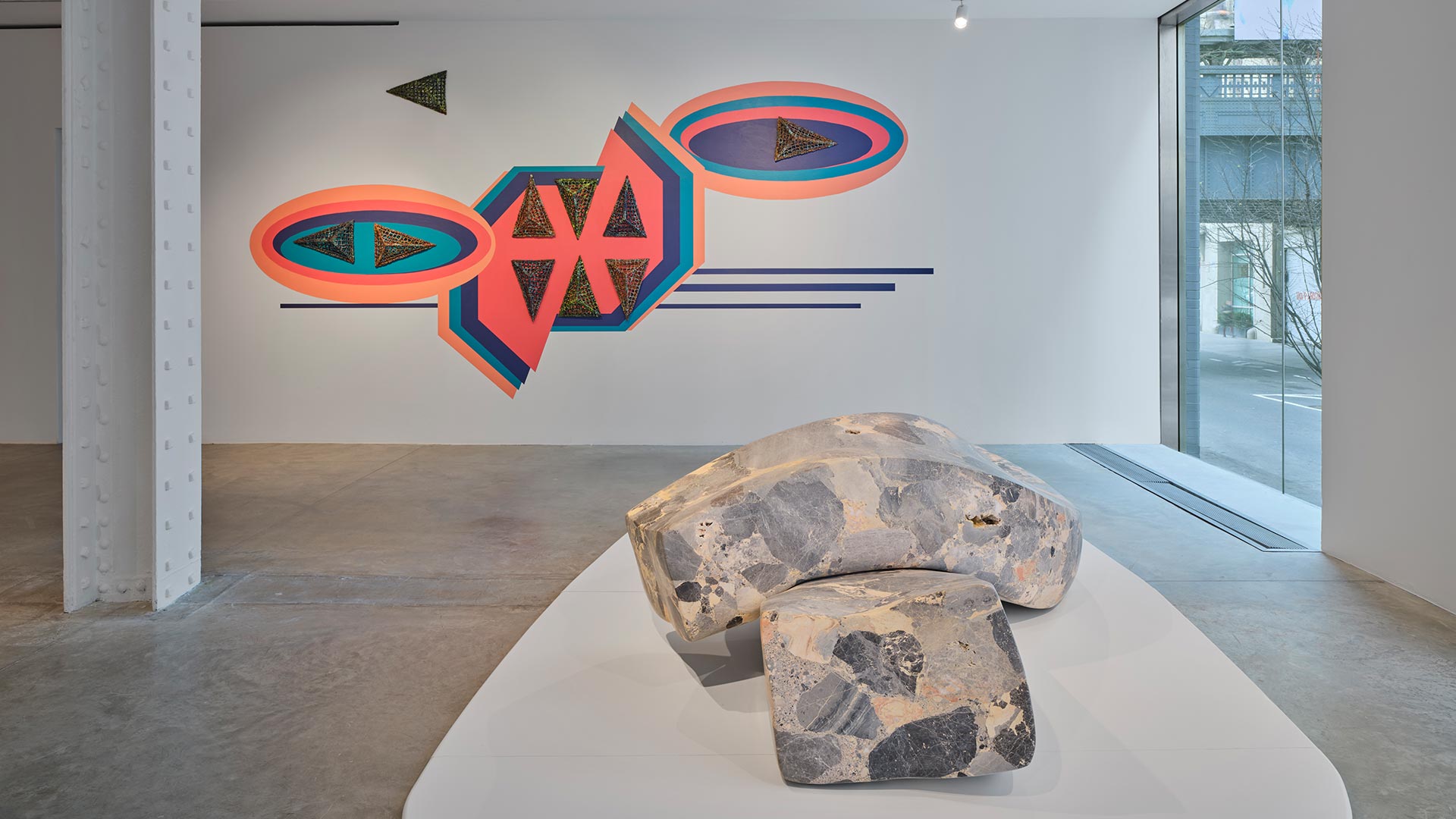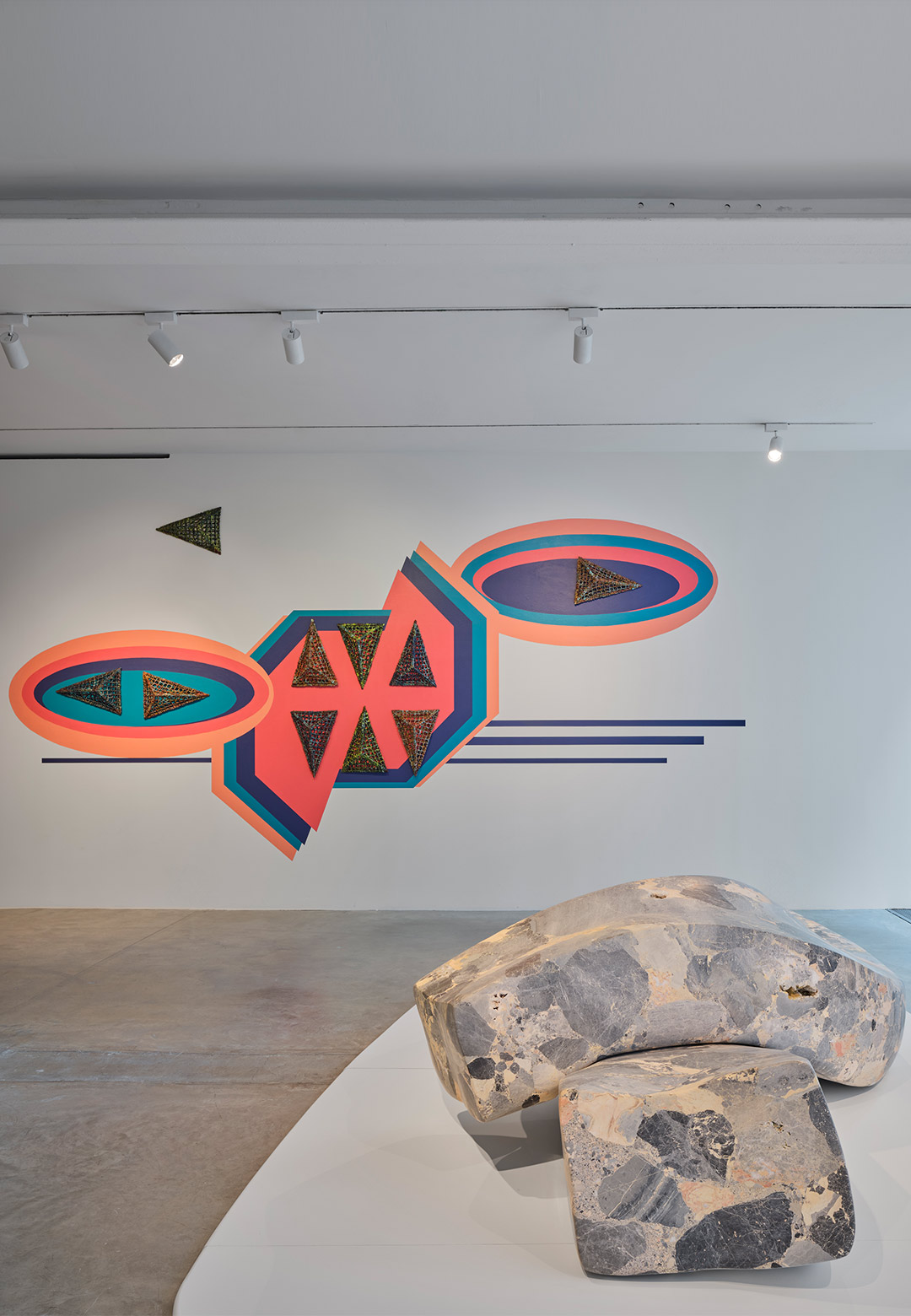There is something inherently unique about mundane pockets of life that transcend into the spiritual, taking us far beyond ourselves—time spent in the star-salted wilderness, or soaking in sunset-drenched skies—experiences that nourish the soul, surpassing into an almost atavistic, non-material state. This state might also be triggered through interactions with non-breathing entities, returning or propelling us towards previously unthought clarities or enquiries, to wrest morsels of meaning from the quotidian. Does design too, have its own theology? Do objects possess or intend towards spirituality when perceived beyond their forms and functions?
A similar line of questioning permeated The New Transcendence, a design exhibition curated by Glenn Adamson at Friedman Benda, NY. On view from January 11 – February 24, 2024, the exhibition aimed to delve into the ‘place of the spiritual’ in contemporary design today. “Transcendence. The word means, literally, “rising above,” and the feeling of it is just that: a certain interval, perhaps sustained, perhaps over in a mere flash, in which the everyday world falls away, and a higher connection prevails. Is it likely—is it even possible—that one could find such uplift in design? The prospect may seem remote,” mentions We Want To Take You Higher, an essay by Adamson that accompanied the showcase.
“Chairs, lamps, cabinets, and vessels are earthly things. They attend to our practical rather than our spiritual needs. They are often regarded as mere commodities, or otherwise cast in a cultural supporting role. What would it take for us to invert these expectations, and to see functional objects as the ultimate vehicle for transport? More than that, to see them as incarnating, on the worldly plane, a quality of transcendence that is sui generis, literally super-human, providing to us nothing but inspiration and requiring little more than reverence?” he questions.
A focused undertaking, The New Transcendence sought to provide provisional answers to these inquiries, through the intensive product designs presented as relics, ritual tools, or representations conceived by its six participants: Italian architect, designer, educator Andrea Branzi, American industrial designer Stephen Burks, Ini Archibong, industrial designer, creative director, artist and musician, Lebanese product designer and artist Najla El Zein, British fashion designer, creative director, and artist Dr Samuel Ross and Courtney M. Leonard, Shinnecock artist, filmmaker, and activist.
“Each of the participants has their own perspective, yet one thing unites them: the impetus to provide an objective, material anchor for the subjective and ultimately private nature of spiritual belief. The immaterial means something different, today, in our digital age – perhaps making physical artifacts more crucial as anchors for [a] transcendent experience,” mentions the art gallery’s press statement. The furniture designs articulating the exhibition, as acknowledged by the creators, not only originate from the designers’ process but “as a result of some larger force, perhaps ancestral, perhaps cosmic.”
The New Transcendence marks the culmination of a trilogy that began with A New Realism (2021), “which looked at pragmatism and craft-based, materially intensive process,” and continued with The New Figuration (2022), “an examination of the nearly unprecedented exploration of the human image in design today,” according to Friedman Benda and Adamson. Like the previous two exhibitions, The New Transcendence is not so much about the designers, but about establishing “a current archetype of practice,” notes the curator, writer, and historian based in New York and London.
The world lost Branzi in October last year, while the exhibition was being organised, and his presence in this exhibition space was intended as a tribute, as well as to his reflections on spirituality. His triptych of Roots chairs that lead the show (like most of his oeuvre) indulged in a profound synthesis where humans, technology, and the natural world “were understood as imbricated in one another,” according to Adamson. The seminal Italian designer’s practice too, pursued this larger integration, an intent accentuating The New Transcendence as well.
“The works we have included here arise at the confluence of designedly procedure with larger, more inchoate forces. Precisely which forces these might be, differ; each of the other five participants may be said to have their own theology of practice. Their philosophies and methods are constituted from domains as varied as animism and artificial intelligence, careful observation of nature and autonomous abstraction. While most of the works on view are furniture, nominally speaking, they occupy real space without being subsumed into its exigencies; what they furnish, primarily, is the mind and spirit,” the essay clarifies.
Excluding Branzi’s chair designs, the creators decided to present just one object from each designer, where they came across as “almost, as allegorical self-portraits,” he continues.
STIR speaks to Adamson on curating The New Transcendence, touching upon how it strayed from partaking in works that spoke to organised religion or spiritual dogmas, with an aim “to discover how design can serve as a vehicle for personal and societal transcendence.”
(The information below also includes excerpts from Adamson’s curatorial note and exhibition essay**).
Jincy Iype: We are deeply interested in knowing what rendered your curation of The New Transcendence, its intent, the choice of its participating creators, and what this ‘new’ transcendence achieves for contemporary design.
Glenn Adamson: Thank you for your interest! As you may have seen, this is the third of a trilogy of shows examining emerging tendencies in contemporary design—it’s an aspect of the gallery’s programming that has also been expressed in collaborations with curators like Felix Burrichter and Omar Sosa. In the case of our three shows, we have been tracking a renewal of commitment to personal sources of meaning, often quite detached from the functional, problem-solving aspects of design for mass production.
**[…the exhibition] departs decisively from established expectations of design. We readily associate it with a range of objectives: experimenting with new technologies, prototyping material solutions, expressing individual sensibility, [and] capturing the zeitgeist. Despite that range, though, design these days is almost entirely secular in intent, and typically very goal-oriented, from the point of genesis to realisation. This is part of its inheritance from modernism, the period when the design avant-garde first assumed a radical posture, [and] repudiated traditional frameworks, including those of religion.
**The New Transcendence marks an emergent re-evaluation in this state of affairs. It is the culmination of a trilogy, three shows each devoted to a developing tendency in design today. […] Now we look in a different direction. Not at what design is made from, and how; not to what it depicts; but to the domain of immateriality itself. We look upwards, in other words, and in doing so, complete a metaphorical arc from raw matter, and its transformation, through the body, to the heavens.
Jincy: In what ways did each showcased work address and contribute uniquely to the exhibition, and what unites their differences?
Glenn: What unites them is a good question, because the works are so different from one another—but I think that reflects the very individualistic aspect of spirituality we are interested in here. This is not a show about organised religion, but rather expressive explorations of transcendence as a domain of feeling, meaning, and resonance, with the object as a vehicle. That is an important part of design practice for each of our participants, but it has led them to very different outcomes.
**[…] The drive towards transcendence is just a fundamental part of being human; perhaps it is the one impulse that most distinguishes us from other forms of consciousness (animal, technological, and those yet to be imagined). This is a final continuity between the present exhibitions and its predecessors... With its last show in the series, we continue this project, now illuminating the discipline’s highest aspiration: the impetus to infuse contemporary objects with a degree of the miraculous. Design, after all, is our emissary in the world. We should expect of it nothing less.
Jincy: In a nutshell, the trilogy aims to establish a “current archetype of practice” or as you mention in your curatorial note, a “developing tendency in design today”—could you elaborate on this?
Glenn: What strikes me most about the whole series is the way that it tracks a trajectory from the earthly and material realm, through the body, to a much less concrete realm—“higher,” one could say, and more elusive or changeable. It’s almost like seeing the same element (design) in solid, liquid and gas form. While each show has explored its own archetypes (the crafted object, the figural object, the resonant object) they all contribute to a larger portrait of the human condition, as designers currently see it.
Jincy: The exhibition assigns, interprets and examines the metaphysical, spiritual connotations of objects of form and function. Why is this perception of design materiality/ immateriality important for a ‘transcendent’ experience and expression, of perceiving design as motifs of transcendence?
Glenn: That’s a great question because usually transcendence and functionality are positioned at opposite ends of an imaginary spectrum. But the way an object offers itself to us, meeting our daily needs and instincts, can itself be a pathway to revelatory experience—maybe all the more so because it is in our everyday life, and not in a remote museum gallery or hanging up on the wall. It’s perhaps in this matter of proximity, paradoxically, that design can affect its own unique transcendental energies.
Curated by Glenn Adamson, ‘The New Transcendence’ was on view from January 11 – February 24, 2024, at Friedman Benda, New York.





 Sign in with email
Sign in with email










What do you think?